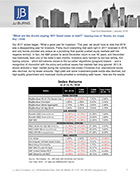“Red and white, blue suede shoes, I’m Uncle Sam, how do you do? / Gimme five, I’m still alive, ain’t no luck, I learned to duck” The Grateful Dead, “U.S. Blues”
Each year that we compose the year-end review seems to include the phrase, “What a crazy year that was”; 2020 was truly that. The year began with markets digesting a strong 2019 and the upcoming U.S. elections (period 1 below), and quickly devolved into the first-ever enforced U.S. recession due to the worst global pandemic in 100 years (period 2 below). The final month of winter and the early spring saw a seesaw of panic and hope roil the equity markets to their worst decline since the Global Financial Crisis over a decade ago. The markets’ forward-looking crystal ball was even more opaque than usual, as the COVID health crisis was accompanied by a financial crisis. Every risk asset was negatively affected, as stocks around the world fell more than 30%, REITs more than 40% and oil fell more than 50%. Imposition of a near-total economic lockdown, a hasty resource reallocation to battle COVID, aggressive action by central banks and most important, hope, led to a stunning rebound after March 23 (period 3 below). The results follow:
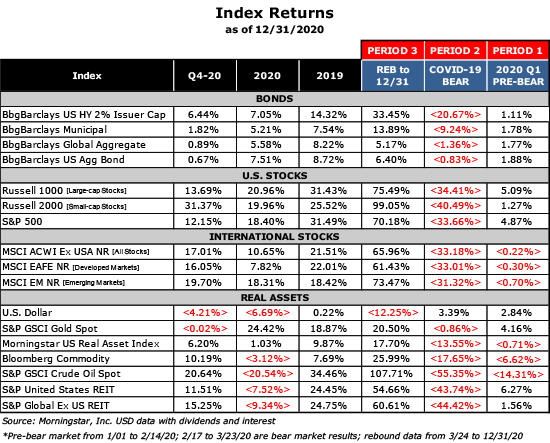
“I want a new drug, one that does what it should / One that won’t make me feel too bad / One that won’t make me feel too good” Huey Lewis and The News, “I Want a New Drug”
While markets may have priced in a robust expected recovery and a ‘technology revolution,’ we join a number of professional prognosticators in a cautiously optimistic outlook for the year ahead.
It seems clear that two things will broadly underpin the rebound we expect: a widely disseminated and accepted vaccine, and a return to positive and sustained economic growth. Let’s briefly look at these two topics in more detail.
Operation Warp Speed helped produce two acceptable vaccines for broad use during the late fall, one each from Pfizer-BioNTech and Moderna, both with high efficacy. Three other firms had vaccines planned for – or in – late-stage trials at year end. This is terrific news. The difficult issue surrounding the vaccine has proven to be getting the jab into global citizens. Inconsistent approaches to purchasing and prioritizing the delivery of the vaccine have led to a disappointing rollout. U.S. President-elect Joe Biden has promised to make the pandemic his top priority by focusing on distribution and invoking the Defense Production Act to dedicate resources to battle COVID. The following graph indicates that the U.S. is mired in a third and possible fourth wave of the pandemic and the scope of Biden’s task:

It is heartening to note that, in the U.S., treatment protocols for the seriously afflicted have improved with time, more and faster testing is available and contact tracing has been implemented. Two potential roadblocks to a successful eradication of the virus (i.e. achieving ‘herd immunity’) are the general flouting of pandemic protocols such as mask-wearing and avoiding crowds, and a willingness to receive the inoculation. This table shows the level of estimated vaccine acceptance in select locales:
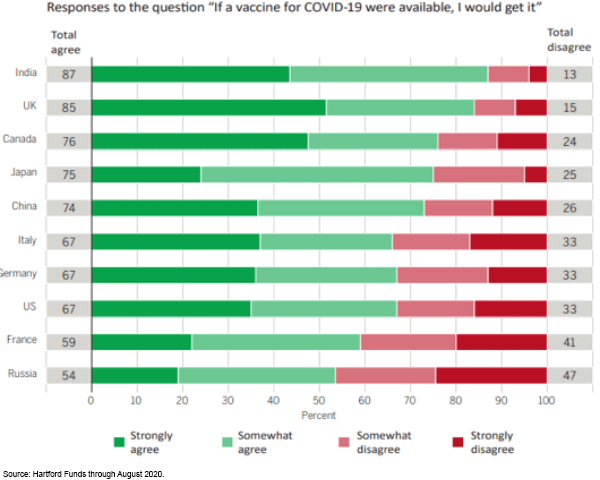
Unsurprisingly, vaccine resources are skewed towards wealthier economies, which may hinder effective immunization protocols in both developed and developing economies. This graph shows the total potential vaccinations as a percent of the subject nations’ populations:
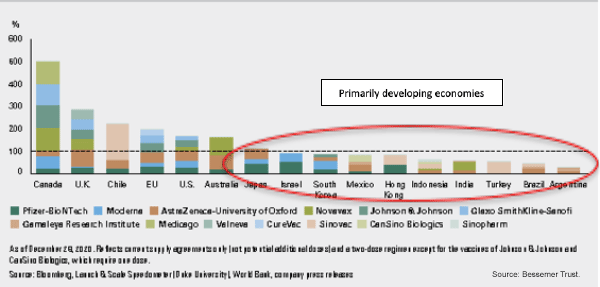
Clearly, getting people inoculated and back to a strong semblance of pre-COVID ‘normal’ activity is crucial. It is also important to note that the 2020 global economic recessions, while severe, were followed by sharp rebounds and broad – but not complete – recoveries. This table details some of the more conservative growth estimates we’ve reviewed. We can see that 2021 World and certain regional numbers are quite good, but quickly taper back to recent trend once the expected re-start effects of the vaccine peter out. Only the non-OECD and Asia & Australasia regions have enviable projections, and those areas include many emerging economies and China. (The OECD has 37 members, mostly from developed economies, that are ‘committed to democracy and the market economy.’)
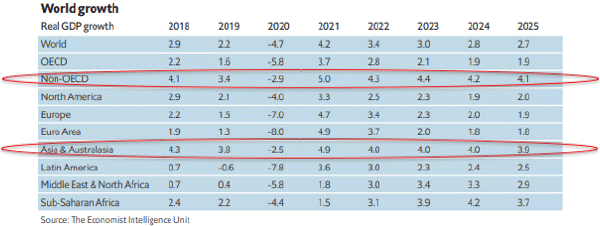
Achieving these rebound and follow-on growth rates implies an increase in fundamental, pre-pandemic activity such as vacation and business travel, attending movies and live events, eating out, booking hotels and simply spending more money. The Bessemer Reopening Index, which measures several high-frequency data sources, indicates a return to about 90% of pre-COVID activity later in 2021:
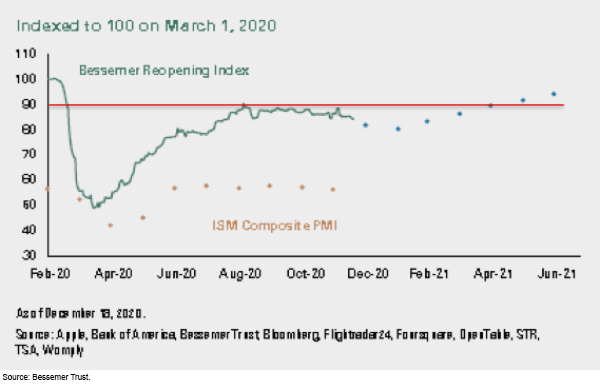
“Give me a job, give me security / Give me a chance to survive” Styx, “Blue Collar Man”
What we also know from reading the headlines and the data is that millions of jobs have been lost due to temporary or permanent layoffs during the pandemic. In the U.S., unemployment spiked and began to quickly recover, but beginning in the summer, the ratio of permanent layoffs began to rise. Every recession sees job losses, true. The extent and duration of the net job losses are the important issues to focus on. Here’s a summary of the pandemic-recession job losses thus far in the U.S.:
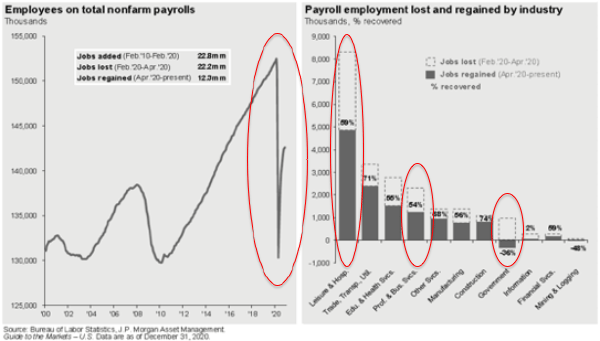
In the left graph, we can see a net loss of about eight (8) million jobs from February to December 2020. The initial losses and rebound were sharp. The right graph demonstrates the industries that have been hardest hit as far as losses and recoveries, most notably Leisure & Hospitality. Despite the distribution issues with the financial relief legislation enacted in 2020, more fiscal support for the jobless and a broad economic re-start plan are necessary to begin moving these numbers in the right direction. In this graph, we can see the hugely disproportionate impact on lower-wage earners of the COVID job losses, which highlights the need for concerted action on the part of businesses and the government:
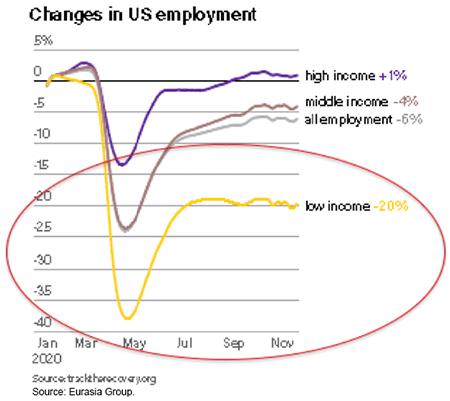
Many of these workers may be gig or ‘off the books’ employees who may not fully benefit from the federal government’s relief efforts. Their spending patterns flow through the entire U.S. economy, most importantly in housing and local purchases such as shopping. We think this growing U.S. income disparity will be a lasting effect of the pandemic that government largesse will not easily remedy.
“You load 16 tons, what do you get? / Another day older and deeper in debt” Tennessee Ernie Ford, “Sixteen Tons”
Two issues that are expected to be headwinds for progress are the economic level of global debt and inflation, respectively. The world has been heavily reliant on low-interest-rate debt since the Global Financial Crisis a decade ago. Central banks have absorbed trillions of dollars of government debt and kept rates very low. Consumers and businesses have been the beneficiaries of this munificence, and robust asset inflation in stocks and housing has resulted. These graphs detail the issue in the U.S.:

The left graph details the high level of debt compared to GDP. We are now approaching a level last seen during WWII, as the economy expanded its war effort. Debt levels began rising under President George W. Bush and haven’t paused since. The most recent spike occurred following President Trump’s ‘expansionary’ 2017 tax cuts. The right graph details the levels of debt spending each year since 1990. Annual deficits skyrocketed during the Global Financial Crisis and began trending down, only to increase again when President Obama left office. Modern Monetary Theory (MMT) argues that, broadly, debt levels and spending can increase in low-inflation / low-interest-rate environments. This may not have the ‘crowding out’ effect economists refer to, but as with the 2020 COVID deficits, a crisis exacerbates the debt problem so that necessary relief may be hindered by bickering around acceptable debt levels. This can is constantly being kicked down the road and, much like Marley’s chain, is already quite ponderous. Here’s a look at the current federal budget:
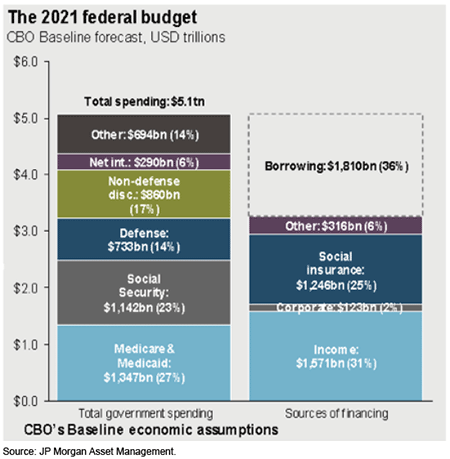
We can see in this graph of the 2021 federal budget that transfer payments (50% for medical and Social Security support), defense (14%) and net interest on the debt (6%) account for 70% of federal spending.
Social Security and Medicare are historically known as the ‘third rail’ of politics, as politicians are notoriously reluctant to discuss any reform to these programs. Medicare is of particular concern, as it is an ‘open-ended’ commitment without defined benefits that govern Social Security payments. Defense spending is also a difficult area to reform due to the local economic benefits of bases and manufacturing. Interest on the debt can be managed with less debt and more maturities. Corporate tax increases expected under the Biden administration will not close the gap.
“I’m trying to make a living / I can’t save a cent / It takes all of my money / Just to eat and pay my rent / I got the blues / Got those inflation blues” B.B. King, “Inflation Blues”
Inflation has also been on the minds of investors. Assumptions of a strong recovery are feared to spur inflationary increases. Most central banks target a 2% cap on inflation, but the U.S. Fed announced last year that it will target an average rate of 2% along with its mandate for full employment. This policy change implies that the economy may ‘run hot’ for periods with no Fed action and higher nominal inflation. Longer-term interest rates have already begun rising, and the prospects of new spending and tax proposals under Biden have contributed to the bond sell-off. While concerns are warranted if a bit premature, our forecast of low inflation for the foreseeable future is based on these trends:
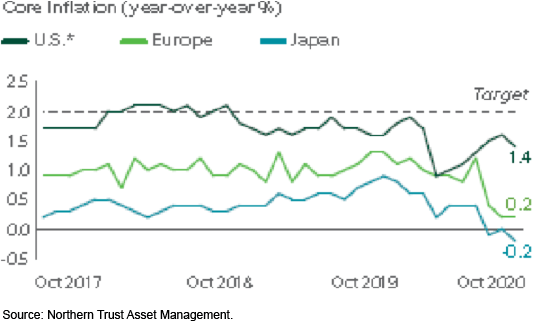
It’s difficult to imagine inflation rising to the Fed’s average target and employment to its mandate in the next few years given the uncertainties in inoculations, virus mutations, economic ‘jump starts’ and other issues we mentioned earlier.
Europe and Japan certainly have a ways to go to meet their inflation targets as well, despite their respective central bank ministrations.
“If you want to make money / You need the luck to make a buck / If you want to be Getty, Rothschild / You’ve gotta be cool on Wall Street” 10cc, “The Wall Street Shuffle”
What should we expect for returns for stocks and bonds, based on the ‘known knowns’ of more central bank support, low inflation, fiscal stimulus and irregular-but-progressing vaccinations? We have the knowledge that thus far, reported company revenues and earnings did not suffer as much as expected in 2020 and will likely rebound further in 2021. With those caveats, we see baseline stock and bond returns that will fall in line with these estimates:
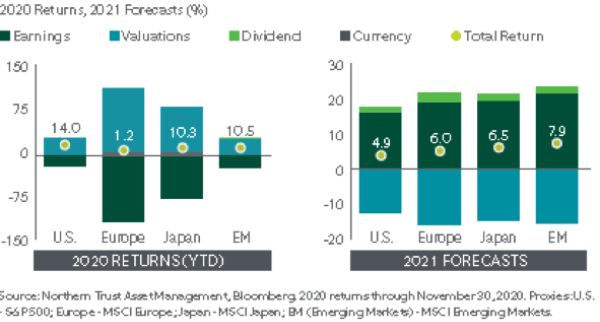
We see several projections that forecast recovering earnings (the dark green in the above graph) offset by lessening market multiples (valuations in light blue).
Notably, expectations of a vaccine and economic recovery pushed valuations up last year and accounted for a good portion of the returns in each of these markets. We think 2021 will present more of a challenge for future earnings growth.
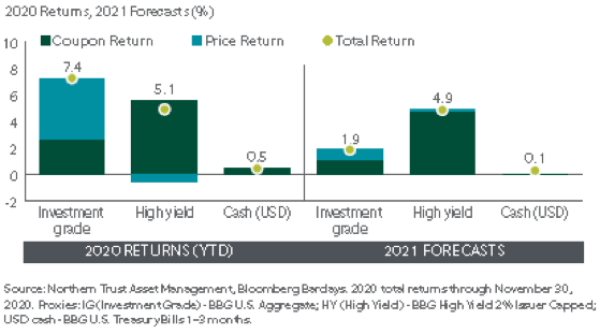
Fixed-income markets have more challenges than do equities. The support for high-quality bonds due to the ‘flight to quality’ and central bank (i.e. Fed) support probably won’t be present this year unless the pandemic flares wildly again. Bonds reversed most of their price declines by year end, so 2021 looks like a year to clip coupon and wait and see how growth and stimulus relief play out.
“The best things in life are free / But you can give them to the birds and bees / I need money / That’s what I want” Barrett Strong, “Money (That’s What I Want)”
A full review of 2020 wouldn’t be complete without a nod to an important issue that many investors are aware of yet continue to neglect: market or index concentration.
Frankly, we were fortunate to have a strong market year last year given the awful pandemic news and the high levels of economic uncertainty. Despite proclamations of a ‘hoax’ or fake crisis, COVID is real and its effects are uncertain, but the full-blown disease is generally awful. One result of the pandemic and the lockdown was the technology ‘push’ due to reduced travel and on-site work attendance. Certain stocks were beneficiaries of this phenomenon on both a real and projected basis, and as a result we saw a wide dispersion in market concentration and returns as these graphs demonstrates:
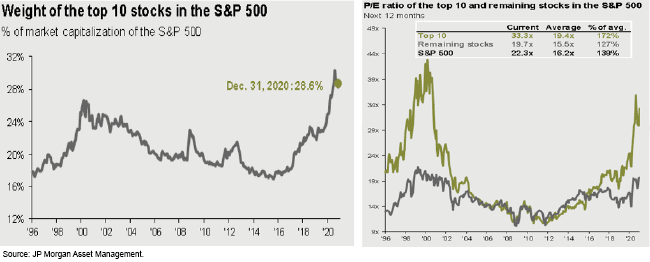
The left graph details the weight of the top 10 names in the S&P 500, which reached concentration levels that exceeded the Tech Bubble in 1999-2000. Unlike that market, the current top 10 have strong franchises and ‘real’ earnings, but they are also shouldering Atlas-like investor expectations.
The right graph demonstrates that, as in the 1990s, multiple expansion has pushed returns but again, has set high expectations for some of those names. We can also see in the inset that the rest of the index, while not cheap, isn’t close to those lofty valuation levels. This does not imply a crash or severe retrenchment, but it does promote some tempering of future expectations for equity investors. Finally, a strong market environment would close the gap between the top 10 and the rest of the market.
“The future’s so bright, I gotta wear shades” Timbuk 3, “The Future’s So Bright, I Gotta Wear Shades”
Our expectations for 2021 results can be summarized as follows:
- A strong rebound in global growth backloaded to the second half of the year.
- As we predicted last year, equities will post solid returns, and ex-U.S. stocks (again) have favorable currency and valuation tailwinds.
- Bonds, barring a crisis, will remain flat for shorter maturities and drift higher for longer maturities.
- The Biden Administration will move swiftly to manage COVID vaccinations and stimulus, look to repair relations with our allies and trading partners, redefine the dialogue with China and look for some marginal tax increases in the reconciliation process.
Last year seemed like the beginning of the 21st century version of the Great Depression. The world faced challenges we’ve never had aggregated in such a fashion. Leading scientists and health-care professionals rose to the occasion and worked tirelessly to combat the deadly virus that spread around the globe. History will show that we owe these individuals a debt of gratitude that we cannot fully repay. We also know that many of you faced some difficult issues and questions, and we trust that we were able to offer wise counsel when you asked. If your financial or living situation has changed or you would like a more detailed update, please contact us.
As always, we welcome your comments, questions and feedback. We wish you and your families a healthy, happy and prosperous new year.
—Your Wealth Management Team at JJ Burns & Company
Download Market Commentary
Disclosure: J.J. Burns & Company, LLC is a registered investment adviser with the U.S. Securities & Exchange Commission and maintains notice filings with the States of New York, Florida Pennsylvania, New Jersey, Connecticut, Georgia, Illinois, North Carolina, and California. J.J. Burns & Company, LLC only transacts business in states where it is properly registered, or excluded or exempted from registration. Follow-up and individualized responses to persons that involves either the effecting or attempting to effect transactions in securities, or the rendering of personalized investment advice for compensation, as the case may be, will not be made absent compliance with state investment adviser and investment adviser representative registration requirements, or an applicable exemption or exclusion.
All investing involves risk, including the potential for loss of principal. There is no guarantee that any investment plan or strategy will be successful.
The foregoing content reflects the opinions of J.J. Burns & Company, LLC and is subject to change at any time without notice. Content provided herein is for informational purposes only and should not be used or construed as investment advice or a recommendation regarding the purchase or sale of any security. There is no guarantee that the statements, opinions or forecasts provided herein will prove to be correct.
Past performance may not be indicative of future results. Indices are not available for direct investment. Any investor who attempts to mimic the performance of an index would incur fees and expenses which would reduce returns.
Securities investing involves risk, including the potential for loss of principal. There is no assurance that any investment plan or strategy will be successful.


